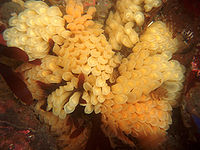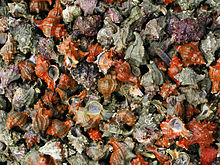- Muricidae
-
Muricidae 
Shell of Chicoreus palmarosae Scientific classification Kingdom: Animalia Phylum: Mollusca Class: Gastropoda (unranked): clade Caenogastropoda
clade Hypsogastropoda
clade NeogastropodaSuperfamily: Muricoidea Family: Muricidae
da Costa, 1776Subfamilies See text
Muricidae, common name murex snails or rock snails, is a large and varied taxonomic family of small to large predatory sea snails. With approximately 1,600 living species the Muricidae represent almost 10% of the Neogastropoda. Additionally, 1,200 fossil species have been recognised (Merle et al. 2011). There are numerous subfamilies, although experts disagree about the subfamily divisions. Many muricids have unusual shells which are considered attractive by shell collectors and by interior designers.
Contents
Shell description
Muricid shells are variably shaped, generally with a raised spire and strong sculpture with spiral ridges and often axial varices (typically three or more varices on each whorl), also frequently bearing spines, tubercles or blade-like processes. Periostracum is absent in this family. The aperture is variable in shape, may be ovate to more or less contracted, with a well marked anterior siphonal canal that may be very long. The shell's outer lip is often denticulate inside, sometimes with a tooth-like process on its margin. The columella is smoothish to weakly ridged. The operculum is corneous, of variable thickness, with the nucleus near the anterior end or at about midlength of the outer margin.
Many muricids have episodic growth, which means that the shell grows in spurts, remaining the same size for a while (during which time the varix develops) before rapidly growing to the next size stage. The result is the series of above mentioned varices on each whorl.
Life habits
Most species of muricids are carnivorous, active predators that feed on other gastropods, on bivalves, and on barnacles. The access to the soft parts of the prey is typically obtained by boring a hole through the shell by means of a softening secretion and the scraping action of the radula. Because of their carnivorous way of life, some species may be considered pests because they can cause considerable destruction both in exploited natural beds of bivalves, and also in farmed areas of commercial bivalves.
Muricids lay eggs in protective corneous capsules the size and shape of which vary with the species. Out of these capsules the crawling juveniles, or more rarely planktonic larvae, hatch.
Historical value
Members of the genus were harvested by early Mediterranean peoples, with the Phoenicians possibly the first to do so, in order to extract an expensive, vivid and stable dye, known as Imperial, Royal or Tyrian Purple.
The fossil record
The family Muricidae first appears in the fossil record during the Aptian age of the Cretaceous period.
Subfamilies
According to the taxonomy of the Gastropoda by Bouchet & Rocroi (2005) the family Muricidae consists of these subfamilies:
- Coralliophilinae Chenu, 1859 - synonym: Magilidae Thiele, 1925
- Ergalataxinae Kuroda, Habe & Oyama, 1971
- Haustrinae Tan, 2003
- Muricinae Rafinesque, 1815
- Muricopsinae Radwin & d'Attilio, 1971
- Ocenebrinae Cossmann, 1903
- Rapaninae Gray, 1853 - synonym: Thaididae Jousseaume, 1888
- Tripterotyphinae d'Attilio & Hertz, 1988
- Trophoninae Cossmann, 1903
- Typhinae Cossmann, 1903
References
- Houart, R. (1994). Illustrated Catalogue of Recent Species of Muricidae named since 1971. 181 pp. [incl. 28 pls.], Verlag Christa Hemmen, Wiesbaden. ISBN 3-925919-19-8.
- Merle, D., Garrigues, B. & Pointier, J.-P. (2011). Fossil and Recent Muricidae of the World, Part Muricinae. 648 pp., 182 colour plates, ConchBooks, Hackenheim. ISBN 978-3-939767-32-9.
- Poutiers, J. M. (1998). Gastropods in: FAO Species Identification Guide for Fishery Purposes: The living marine resources of the Western Central Pacific Volume 1. Seaweeds, corals, bivalves and gastropods. Rome: FAO. page 553.
- Rosenberg, Gary (1992) The Encyclopedia of Seashells. New York: Dorset Press.
- Vaught, K.C. (1989) A Classification of the Living Mollusca. American Malacologists, Inc., Melbourne, Florida.
External links
Categories:
Wikimedia Foundation. 2010.


